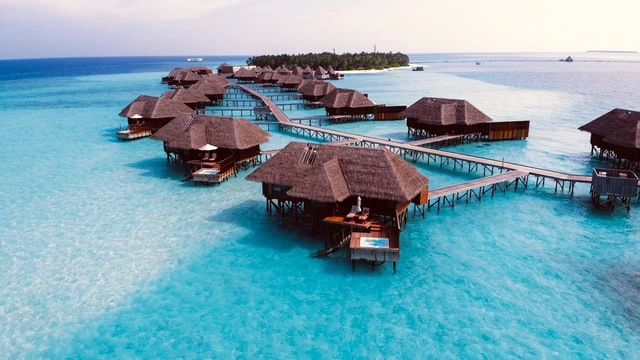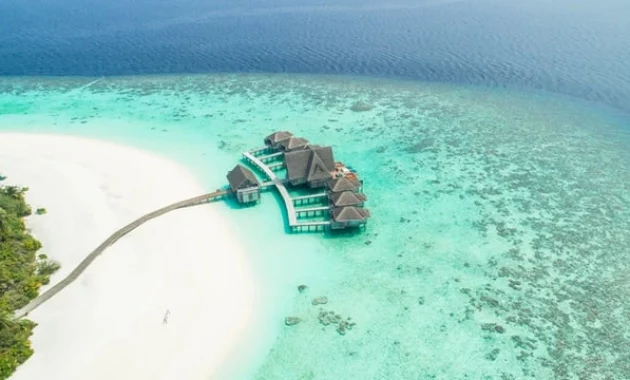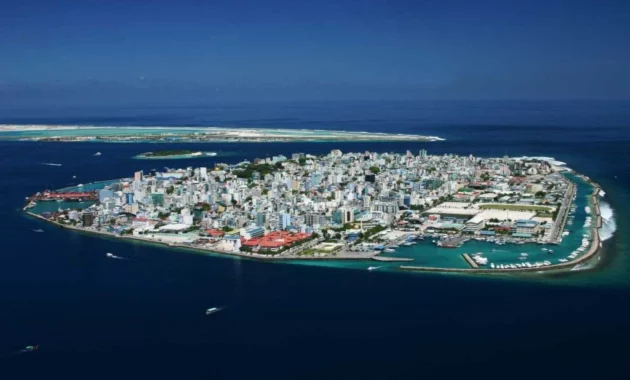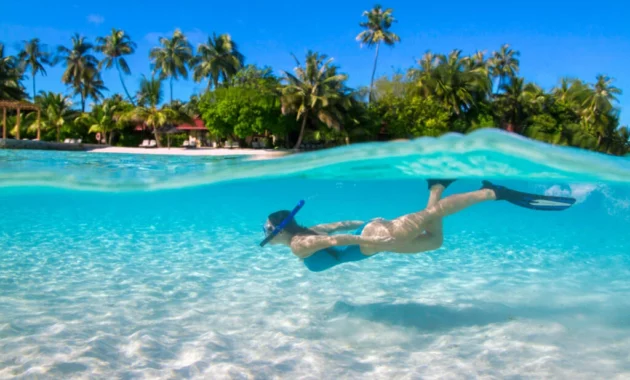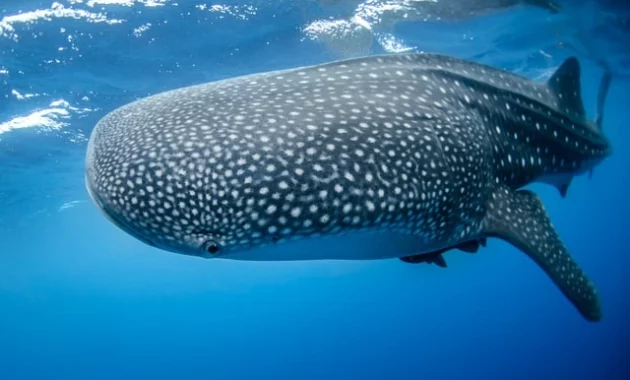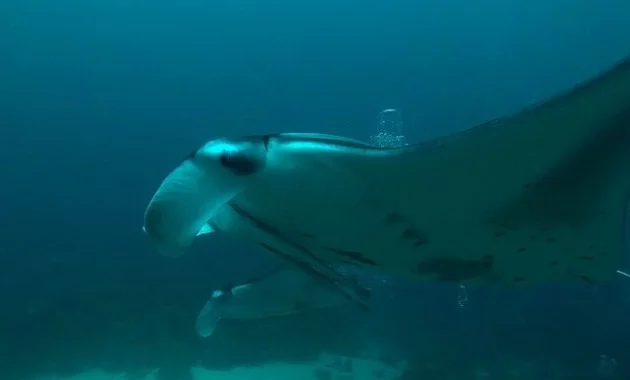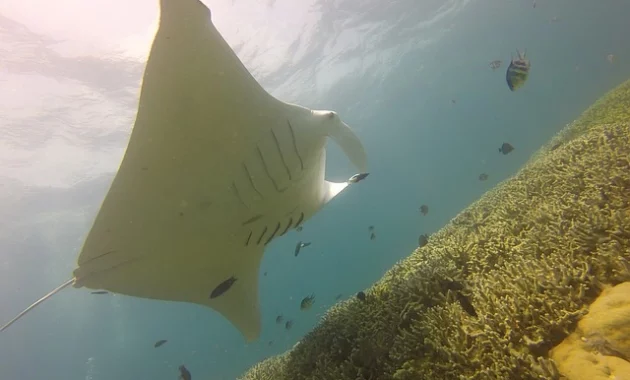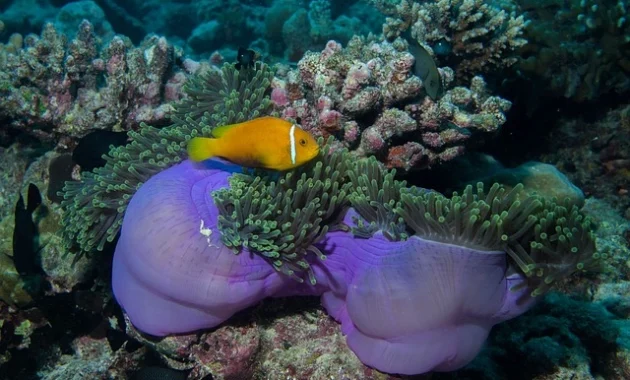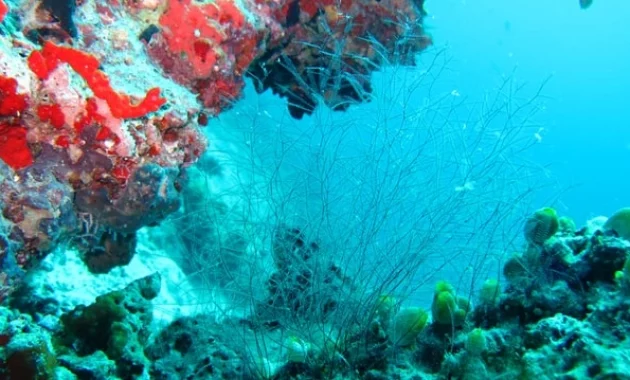Many tourist destinations are rightly fighting for the title of the most beautiful place in the world. But that fight has long been resolved in favor of the Maldives. Do you disbelieve or disagree? Then you haven’t seen or dived in the Maldives!
One thing is for sure, you will remember the Maldives for a lifetime from the first second you see them from a plane, landing at the main international airport on Hulhule Island near the capital Male. Unreal scenes like a pearl necklace of scattered turquoise green atolls in fantastic blue simply can’t leave anyone indifferent.
- Amazing resorts
- Are the best diving spots here?
- Diving offer in the Maldives
- Diving cruises in the Maldives
- Your boat will be top class
- The diving safari of your life
- Alimatha jetty
- Ari atol
- Whale shark season
- Swim with the whale sharks
- Night diving with manta rays
- Observing the manta rays
- Maaya Thila
- Vilamendhoo Thila and Bathala
Amazing resorts
When you find yourself in the Maldives, you will really “end up” in one of the resorts exactly as you see in the commercials. A small island, unreal white sand, a row of palm trees, and a turquoise sea that is only yours. On the island, there are only magical small bungalows and a reception. With a small restaurant and a mandatory diving center. If you want, you can also spend the whole day in your piece of paradise without meeting anyone. Because, if there are more than fifty people on the island, then it is an extremely large Maldivian resort. And such are in the minority. Apart from a magical holiday for everyone, the Maldives is a widely known diving destination.
Are the best diving spots here?
We will stop here and admit that there are many destinations that have at least the same quality of diving as here. There is no way you can say that the Maldives are better than the Galapagos, Rangiroa, Fiji, or Raja Ampat in Indonesia. But it is also difficult to classify the Maldives in the “lower class” compared to the aforementioned diving paradises. So, it would be fairest to say that the Maldives is a top diving destination. Equal to all the others that we can rank among the “best in the world”, but with one important determinant! If we combine the quality of diving with the quality of the destination itself. Then the Maldives convincingly take first place. Tastes vary, but rarely can anyone provide a meaningful counter-argument.
This coral archipelago is located just south of the Indian subcontinent, at the equator. Diving tourism is the main economic branch of this country, which is probably the only case in the world. The population is predominantly Islamic, and the capital is Male, located on the eponymous atoll. The Maldives consists of a dozen larger atolls, made up of hundreds of small magical sand islands. So far, about a hundred of them have been turned into resorts. And most are uninhabited, and few are inhabited by natives. The very mention of the name of the resort almost entices you to visit it. Bandos, Kanifinolhu, Embudu, Velavaru, Alimatha, Kuredu….
Diving offer in the Maldives
The Maldives provides several almost equally attractive options for scuba divers. So we can generally divide them into resort diving and cruising. If you enjoy being alone on your own beach, with a light activity of two, three dives a day, then the resorts are the right choice for you. Each of the resorts in the Maldives has its own diving center. Thus you can choose blindly if you want “only” pure diving pleasure. If you are attracted to encounters with certain animals or locations such as Hanifaru Bay for manta dancing. Rashdoo atoll because of the hammerhead sharks, or southern Ari because of the whales. Then it is best to study the offer before the trip. Due to the favorable time of year and certain centers that lead to just such locations.
Diving centers
Another very interesting option that includes resorts is diving centers that offer “no – limit diving”. In such places, due to the favorable configuration of the reef, a fixed price is offered for a weekly diving package. In which you dive without restrictions – at the “house reef”. Weekly packages of $400 to $500 USD allow you over twenty dives. Of course, if you are physically ready enough. A very affordable option for diving enthusiasts. Or for example for photographers who can “work” on the desired subjects in peace.
Diving cruises in the Maldives
Today, diving cruises (popular safaris) are becoming more and more popular. Relatively rare in the past (and therefore expensive). Today they are more frequent, so their price has dropped seriously and today it is no problem to find cruises for less than $ 1500 USD (without a flight, of course). As you might guess, the best locations are targeted on cruises. Usually on the stretch of one or two larger atolls. So they have become very popular and sought after. Their price is still falling due to the ever-increasing offer.
Your boat will be top class
The quality of the boat is standardized so you will definitely have a decent level of luxury. Double cabins with private bathroom, air conditioning, TV should be standard, with a package of about twenty dives a week. The most popular are weekly tours that depart from the capital Male and then along the Male South Atoll to one of the largest – Ari Atoll. There are also some more exclusive longer tours to the far south atolls like the one in Nilandhoo south. But they are still a bit more expensive. The Male – Ari tour, although standard, is truly top-notch and will provide unforgettable moments.
The diving safari of your life
After enjoying the view on landing and the heat shock after getting out of the air-conditioned plane, you’ll be looking forward to boarding a boat to head to some of the most beautiful locations in the world. A classic Maldivian tour from Male to the south involves the first dives on Male Nord Atoll. Where are located some of the oldest resorts in the Maldives. The likely choice is Kurumba reef, a classic Maldivian script.
White-type sharks and turtles can be found here, although the location is nowhere near spectacular. Simple configuration and low currents are ideal for your guides to easily lead the whole group and organize further dives. Some of them will be a bit more demanding, so caution is never out of the question.
Alimatha jetty
Diving on the pier of the Alimatha resort is really fascinating and you almost don’t believe what you’re looking at. It’s a night dive that starts just before dark to get to know the terrain, a gentle sandy slope. At first glance, nothing special, but the real action starts with darkness when more and more really big nurse sharks start coming out of the darkness. A somewhat comical species of sharks with extremely small eyes and a characteristic mustache.
All you have to do is kneel on the seabed and enjoy the magical scene in front of you. Nurse sharks circle around you and occasionally descend to the sandy bottom. They are distinctly nocturnal animals and then feed on shrimp, octopuses, cuttlefish, and smaller fish. Alimatha is interesting to them because the lights of the resort attract their food, so divers have the opportunity for an exclusive experience. In addition to nurse sharks, rays and even small tunas commonly appear. Nurse sharks are already used to the presence of divers, so they allow touching. And rays up to two meters in diameter almost crash into divers, rummaging in the sand looking for small shrimps and shellfish. It’s funny how sharks occasionally lie on the sand right next to divers, just like faithful dogs we have at home.
Ari atol
The second day of the cruise is very likely (depending on the weather) followed by a move to Ari Atoll. One of the most famous in the Maldives. The atolls are otherwise very low (the highest natural altitude in the Maldives is only a few meters), so you hardly notice them from the boat, with the exception of numerous palm islands. The target is the extreme south of the atoll, the location of the Maamigili channel. The canal is located between Ari Atoll and Nilandhoo, and the main attraction here are the whales that can be encountered almost all year round.
Whale shark season
The main season for whale sharks is approximately between April and September. When the sea is richer in plankton, whale sharks gather in the area. But at this point, it is realistic to expect them almost all year round. Except for November to January. Whale sharks patrol at shallower depths along the canal, so experienced shipowners will first circle the site for some time and visually observe them.
Swim with the whale sharks
After that, as in the army, there is an “alert”. And hurriedly equipping you rushing towards the dhonis – Dhoni is a traditional multi-purpose sail vessel. There you dive in extreme currents. And encounters with whale sharks are generally short-lived. This is another thing to remember for a lifetime. Huge whale sharks glide gently along the very surface, and you need to wave your fins like crazy to keep up with them. As long as you can. Not simple at all, but it’s unforgettable.
Scuba diving is followed by a rest on the boat. The captain and crew are constantly patrolling the area and as soon as a new opportunity arises they jump into the sea. Even if only with a mask and a snorkel. The whole day is spent in the water area of several square kilometers. The whale sharks are actually sharks and considered by many to be one of the most beautiful. They have a characteristic, large, almost rectangular head with small eyes and a wide mouth with which they filter the sea. They feed on plankton and possibly smaller fish. And their length can reach over 35 feet. What everyone remembers are the incredibly beautiful patterns made up of white stripes and dots on the bluish body. They do not run away from people because they do not consider them a threat.
Night diving with manta rays
Another undoubted “highlights” of diving in the Maldives are the possible encounters with graceful manta rays. By far the most famous location is Hanifaru bay, which is located on the somewhat northern Baa Atoll, so it is not part of this “classic” route. “Hanifaru madness” is best experienced by cruising in the north or staying in several local resorts. But manta rays are everywhere in the Maldives, so the only question is how to find them… During the high season and during the day it is very difficult, although it happens. In the low rainy season, encounters are more frequent, especially within Ari atolls in numerous lagoons. They are often encountered at the locations of Moofushi reef and Mafush thill, but the spectacle follows only on night diving. The boat simply anchors anywhere in a suitable lagoon and strong ship’s spotlights light up just above the surface.
Light attracts planktonic organisms, and plankton attracts manta rays. In just a few minutes the magic begins as an unforgettable mantle dance follows. All you have to do is equip yourself and kneel on the shallow bottom. For an hour, you won’t even move, enjoying the graceful hovering of just one or five or six mantles that actually feed frantically on a free dinner.
Observing the manta rays
It is not uncommon for manta rays to run into divers in their “greed” for plankton, so at the last moment, they jerk their bodies upwards, just before they could hit you on the mask. Then you have a “close up” observation of the lower body of the mantle incredibly white as it passes just above your head. You can practice such dives almost every day if you have such an agreement with the crew or cruise organizer. What is quite certain is that none of them will be boring.
Alternatively, you can spend some of the evenings on one of the uninhabited islands in the lagoons with some “barbecue” on the sand. Which the ship’s crew will most likely gladly afford to you. Of course, the crew also expects a tip from you at the end of the cruise, and the tip is always well deserved. The likable Maldivians, Sri Lankans, or Vietnamese on board really work very hard and unobtrusively to give you safety and enjoyment.
Maaya Thila
Once you are on Ari Atoll, then it would be a real shame not to dive into one of the most famous locations. And that is Maaya Thila near the islet of Maayafushi. “Thila” is a term you hear very often in the Maldives, and describes lonely smaller or larger underwater reefs surrounded by a sandy bottom. They are usually found in places exposed to currents, so they are usually overgrown with numerous tropical gorgonians and anemone wig fields. That’s why they’re always fantastic for diving, especially since you can also expect sharks, napoleons, turtles, and many other fish species. Diving on Thilas can be a bit more demanding due to the mentioned currents, but it will certainly be very dynamic.
Maaya Thila is known for its specific form of almost square shape. And in the northern part, there are overhangs with gorgonians and shoals of glassfish. Whitetip sharks, occasional rye, and turtles are circling everywhere, and there will be many curious Muarenas in the caverns. In the immediate vicinity and at a slightly greater depth (up to thirty meters) there is another smaller Thila. Around which there are usually even more sharks. The top of Maaya’s Thile is flat and is about ten meters away. The end of the dive at the top is also very interesting because the Thila is covered with many fields of anemones and “belonging” clownfish.
Finishing the dive at the top is also very interesting. Because Thila is covered with many fields of anemones and “belonging” clownfish. If you look closely at the blue water, you may also see some tropical purple jellyfish. Maaya Thila is a location that you almost always dive in it twice. Because you will hardly see everything in just one dive. So don’t make the mistake of accidentally skipping another dive because you think you might be bored. This is impossible here.
Vilamendhoo Thila and Bathala
In addition to all these previously mentioned locations, on a cruise like this, there will be many more opportunities for unforgettable dives in less “famous” locations. But there is much more to come. You will have the opportunity to visit two interesting wrecks at locations next to the Fesdu and Machchafushi resorts. One was stranded on the reef, and the other was submerged intentionally to create an artificial reef. Both are very interesting with a multitude of animals.
Another famous location is Vilamendhoo Thila. It has similar characteristics to Maaya Thila. A few manta rays can be found here, but what you might see here is a much rarer Mobula ray. The module rays are somewhat reminiscent in shape of manta rays. But they are distinctly gray. Almost silvery and are often seen in small groups. Some call them “devil ray”.
Diving on cruises like this almost always ends on Bathala Island. Located on the northeastern edge of Ari Atoll. The nearby reefs also provide fantastic dives that will complete the wonderful experience full of pleasures.

